
For this long-awaited return to Cartoon Research, I have to thank Steve Stanchfield who has generously handed over his usual “Thunderbean Thursday” slot. Behind the scenes here at Cartoons On Film headquarters, the gears of early animation archiving and restoration have been steadily (and quietly) turning for the better part of the year. I’m looking forward to sharing many exciting new silent animation restoration-related developments with Cartoon Research readers over the coming months.
The first thing I’d like you all to know about is a very special Turner Classic Movies broadcast, taking place less than a day away from this posting. My sincerest apologies for not giving readers more advance notice about the following programs. This all came together at the very last minute, and all persons involved were simply unable to spread the word until everything was completely finalized!
Tomorrow, Friday morning, at 6am and 7am Eastern, TCM is airing two blocks of newly restored silent cartoons—all coming exclusively from me and my teammates at Cartoons On Film. The shows are, respectively, Century of Animation Showcase: 1923—a look into animated shorts from a hundred years ago—and Walt’s Early Wonderlands, a showcase of Walt’s and Ub Iwerks’ efforts predating a certain famous cartoon mouse. For those of you who get TCM, but won’t be up that early in the morning to catch the live broadcasts, I certainly hope you can DVR the shows for primetime enjoyment. (As for me… sleep, what’s that?)
Both programs will feature hosted introductions with two of Cartoon Research’s most esteemed contributors. Jerry Beck will speak to viewers about the 1923 showcase, and J.B. Kaufman will most appropriately be doing the same for the Walt program.
In selecting films for both programs, I wanted to pair a few commonly-circulating items with a variety of very rarely seen items. In some cases, my team and I are excited to be bringing you stunningly clean restorations of 35mm elements that have not been seen by the general public in many decades. Silent cartoons are rare enough in smaller gauge 16mm “reductions” or “dupe” prints, which often suffer from poor picture quality. Therefore, the ability to see any of these films coming from 35mm elements is a real treat, and I’m honored to have been able to produce these new versions—and liberate the films again, at all—for the public to enjoy.
I’ve asked my longtime friend and colleague David Gerstein, another contributor to this TCM project and a Cartoons On Film veteran, to contribute a few “liner notes” here about the individual films in the programs. We’ll start with the 1923 retrospective:
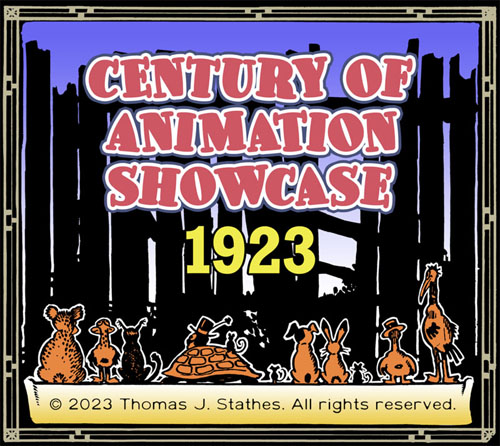
Felix Wins Out and Felix Strikes it Rich (1923): Developed by Pat Sullivan Studio chief animator Otto Messmer, Felix the Cat was among the most charismatic silent-era characters—and in terms of merchandising, its undisputed superstar. In Wins Out, Felix’s adventures at a circus show off Messmer’s talent at drawing various wacky circus performers and animals. Strikes it Rich features Felix’s very 1920s love of jazz—as he foregoes his usual hungry chasing of barnyard chickens to play the sax for them instead!
The Jolly Rounders (1923): While many funny animal characters existed before Felix, Messmer’s success led many of his peers into the field in an unprecedented way. Paul Terry, previously best known for the adventures of the human Farmer Al Falfa, utilized his Aesop’s Fables series to introduce numerous animal stars alongside the farmer. Loutish Harry Hippo and his rightly distrustful wife starred alone in several Fables shorts—including this one. While Jolly Rounders was featured in our 2012 TCM program, we’ve updated it here with better quality from a superior film transfer.
Fortune Teller and Puzzle (1923): “Out of the Inkwell” comes Koko the Clown, creating mayhem in the studio of his real-life human boss, Max Fleischer. Koko’s motions were originally created using Fleischer’s famous rotoscope technique—which involved tracing them from the live-action capers of Max’s brother and business partner Dave. But by 1923, Koko was frequently engaged in wild, abstractionist comedy that no live action could match, often animated by inimitable new Fleischer recruit Dick Huemer. 1923 was also the year in which Koko was first called by that name; he had carried formal titles like the “Goldwyn-Bray Clown” and the “Inkwell Clown” up to that time. Our stellar pianist and composer friend, Charlie Judkins, provides magnificent scores for these shorts, incorporating “The Yama-Yama Man,” the song that—as performed on stage by clown-girl Bessie McCoy—inspired Koko’s original look.
Col. Heeza Liar, Detective (1923): The windy, tall-tale-telling Heeza Liar was cartoonist and producer John Randolph Bray’s own creation, and the first recurring character created specifically for animated cartoons. Later entries in the series—like this one, previously seen in our 2014 TCM show and given some extra restoration for this revival—imitated Fleischer’s concept of having the star exist as a “real-life” cartoon star effectively boarding at his studio. New Bray recruit Walter Lantz, later the studio head behind Woody Woodpecker, didn’t direct Detective, but plays two live-action roles in the short. Robert Israel and the Robert Israel Orchestra are on hand to offer an excellent background score for the adventure.
Chicken Dressing (1923): Earl Hurd, creator of the mischievous little boy Bobby Bumps and his dour dog Fido, originally featured them in wild adventures in their cartoon hometown. But in Fleischer’s wake, Hurd—like Bray—recast his heroes as “real-life” cartoon characters heckling their boss and other studio guests. In this short, originally restored for our Cartoon Roots Bobby Bumps collection, several excellently-trained animals were added to the mix—as is Charlie Judkins with an excellent organ score.
And now, the films in Walt’s Early Wonderlands, all new to Cartoons On Film — but eventually to be issued again as part of a future Blu-ray project. Special thanks to Steve Stanchfield and his team for burning the midnight oil on many of these great new restorations.
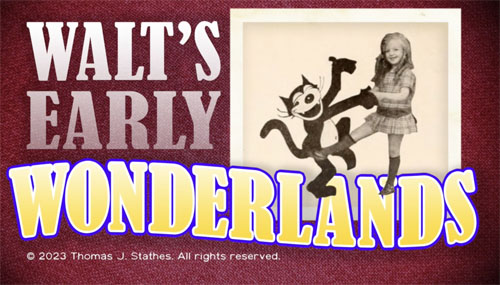
Newman Laugh-O-grams No. 5 (1921): While some of us have seen this early collection of animated gag cartoons, produced for Kansas City’s Newman Theatres, this vintage 1930s element is the only print we’re aware of to contain the original end title, confirming that this was the fifth in a series of similar shorts.
Puss in Boots (1922): Disney’s early silent animated star, a cat eventually called Julius and redesigned as a Felix mimic, was born in seven Laugh-O-grams fairy tale shorts made in 1921-1923. In these early films, the cat also shows the influence of George Herriman’s Krazy Kat, right down to Krazy’s indeterminate gender. Here, he/she can be seen romancing an Officer Pupp-like male dog—to the strains of another new Charlie Judkins score.
Alice and the Three Bears (1924): The Alice Comedies featured Julius as the animated lead opposite a live-action little girl as Alice. The series also saw Julius defined permanently as male. But while later episodes featured him romancing female cats, this earlier entry from Walt and Ub shows Julius in love with Alice herself. Julius and Virginia Davis as Alice finish this story with a romantic moment that we’re pleased to show complete. (Many prints partially edit it out.)
Alice Loses Out (1925): This tale of Alice and Julius running a hotel was known until recently from early 1930s reissue prints, which replaced the title sequence with a redesigned card. After acquiring the collection of late Queens animator and film collector Bob Lusk, Tommy found a small roll of 35mm that was sold as a “Felix” toy film, but actually contained a previously unknown Julius segment. Upon viewing it, J.B. Kaufman and I were thrilled to see that it was an original, extended-length opening scene for this cartoon, with Julius breaking the fourth wall, pushing the original title card aside, and bickering with the theatre bandleader in the orchestra pit! As for Alice, by this time in the series she was portrayed by Margie Gay.
Alice’s Little Parade (1926): Restored from two 35mm prints of variant quality, this World War I-inspired story—its title mimicking the then-recent King Vidor movie The Big Parade (1925) — features Julius as a soldier. Disney and Iwerks would later reuse many gags from this cartoon in war-themed Oswald and Mickey shorts. Both the rabbit and mouse, like Julius, think they’re getting ahead in battle when enemy commander Pete unexpectedly corners them.
Trolley Troubles (1927): Oswald’s second-produced, first-released film is seen here with Universal’s reissue soundtrack, prepared by the Walter Lantz studio when this cartoon returned to theatres in 1931. Ub Iwerks outdid himself with amazing squash-and-stretch action as Oswald’s trolley bounces over some impossibly steep hills and valleys.
Oh, Teacher! (1927): Another early Oswald short finds him battling with a rascally cat for the affections of his original girlfriend, a rabbit sometimes called Fanny Cottontail. While the cat rival looks a little like later versions of Julius, he’s actually a meaner, tougher character who would feud with Oswald again in The Ol’ Swimmin’ ‘Ole (1928), and more-or-less evolved into Mickey’s occasional comics rival Kat Nipp.
The Mechanical Cow (1927): For our final Oswald selection, we’re pleased to bring you a version of this cartoon that’s a little more complete than usually seen, with splice-free footage covering the sequences of Oswald feeding milk to Mrs. Hippo’s baby, then meeting Fanny coming through the rye. And now back over to Tommy…
Thanks, David.
Some of you might be thinking “Darn, I don’t get TCM”! Worry not. All the “new to Cartoons On Film” shorts in these programs will be included in future Blu-ray/DVD collections from me, including future releases in the Cartoon Roots series. When I have more news on those developments, I’ll be sharing it here at Cartoon Research.
In the meantime, TCM and its viewers get first dibs on the completely new restorations being debuted in these programs.
For those readers who may have missed some of Jerry Beck’s, Steve Stanchfield’s and my past collaborations with TCM, I wanted to momentarily call attention back to some of those yesteryear projects. Our trifecta – that being my Cartoons On Film label, Steve’s Thunderbean Animation, and Cartoon Research’s Jerry Beck – has enjoyed a cherished association with Turner that now spans more than a decade.
Way back in 2012, I had the honor of programming a selection of rare, early Made-in-NYC silent cartoon shorts. You can read more about that program here. Turner staff invited Jerry to appear in live hosted introductions for the shorts, staged in the form of a conversation with the late, great TCM host Robert Osborne. [LINK]
This early 2010s marked the start of my foray into producing new silent cartoon restorations, after spending several years mostly focused on finding and archiving physical prints. That early digital restoration work was performed almost entirely by Steve at the time. He and I have learned a lot in the decade since, and have enjoyed great advancements in digital restoration technology as well. Some of our earliest digital restorations, in fact, aren’t quite good enough for our current standards! We did what we could with the knowledge and tools available to us at the time, and the 2012 program served as an important watershed moment in getting this kind of obscure, forgotten early animation material onto Turner Classic Movies in any form.
Two years later, in 2014, we “did things up” in an even bigger way by teaming up to create multiple TCM programs, with separate entries for Cartoons On Film and Thunderbean. As 2014 marked a century since the formal incorporation of the Bray Studios, I thought it would be fitting to program a showcase of that studio’s mostly forgotten films. For this, I had the incredible privilege and honor of co-hosting with Robert Osborne. That was a life and career-changing experience I’ll simply never forget. More info on that program here.
Sharing the evening with me in 2014 was watershed early-animation historian John Canemaker with a selection of Winsor McCay silent cartoons; Steve’s program, originally intended for that same night, was postponed due to a computer glitch at TCM and appeared two months later, with a magnificent selection of Thunderbean’s beloved Van Beuren restorations. Technology… we can’t live with it, we can’t live without it!
Steve and I were off the TCM schedule for a few years after that, but remained busy with our various Thunderbean and Cartoons On Film releases, which for Steve included several Van Beuren collections and Ub Iwerks’ Willie Whopper, and for me included Cartoon Roots collections of Bobby Bumps and Felix the Cat.
In 2015, many colleagues and I also provided footage and interviews for Andrew Smith’s exciting Cartoon Carnival documentary: an intimate history of silent animation and its modern recoverers, available today from Century 21 Films Ltd: [LINK]. I was honored to play a major role in Andrew’s documentary, and after a long gestation period, it came to TCM in 2021. But it didn’t arrive alone!
2021 was also the year in which I announced Cartoon Roots collections for the Fleischers’ Out of the Inkwell cartoons and Walter Lantz’s Dinky Doodle and Pete the Pup. My Fleischer restorations had already been in the works for some time at this point, so that year was a perfect opportunity to showcase that studio in a new Cartoons On Film/TCM retrospective, which accompanied Cartoon Carnival to the air.
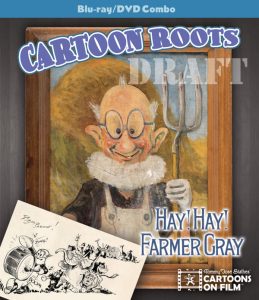 In 2022, David and I announced a Paul Terry-themed Roots compilation, originally called “Hey, Hey, Farmer Gray” (look for it soon under a title I prefer, “The Life and Times of Farmer Al”). We’ve been at work on the Inkwell, Dinky, and Farmer Al sets ever since—and from them several more Cartoons On Film TCM hours have resulted, including last year’s “Century Showcase” for 1922, as well as this year’s for 1923. While vintage silent films are sadly rare, enough 1920s titles survive that industry-wide surveys like this can be made on a year-by-year basis.
In 2022, David and I announced a Paul Terry-themed Roots compilation, originally called “Hey, Hey, Farmer Gray” (look for it soon under a title I prefer, “The Life and Times of Farmer Al”). We’ve been at work on the Inkwell, Dinky, and Farmer Al sets ever since—and from them several more Cartoons On Film TCM hours have resulted, including last year’s “Century Showcase” for 1922, as well as this year’s for 1923. While vintage silent films are sadly rare, enough 1920s titles survive that industry-wide surveys like this can be made on a year-by-year basis.
I’ve also had the honor of working with fellow New Yorker and film collector Ronald Schwarz, creator and director of Before Mickey Mouse (1982), the first feature-length documentary showcasing silent-era animation. I secured the rights to Ronald’s anthology after decades of wanting to see it revived. It will soon reappear on physical media; in 2022, TCM was the best place to re-debut it in a new light restoration.
I’m always looking forward to similar opportunities in the future, and in a variety of different venues… always including Turner Classic Movies.
Coming back now to the current moment, it’s all well and good to talk about what’s “coming up next” on TCM. Before signing off, I wanted to express a sentiment that I’m sure is being felt right now by a long list film critics and historians, as well as innumerable cable-subscribing cinephiles in North America: I’m incredibly glad Turner Classic Movies continues to forge ahead in the form and shape that its fanbase loves. The future seemed rather bleak for the channel just a few months ago, when higher-up decisions temporarily gutted much of the creative talent behind TCM—essentially depriving TCM (and its viewers) of the channel’s lifeblood and spirit. With the eventual reversal of some of those decisions came a collective sigh of relief. Fingers crossed for this essential channel’s ongoing legacy. Steve, Jerry, Andrew, David, my other colleagues, and I are so grateful to have worked with them.


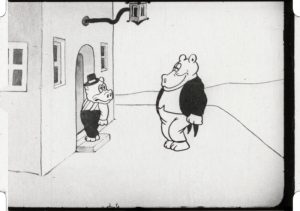
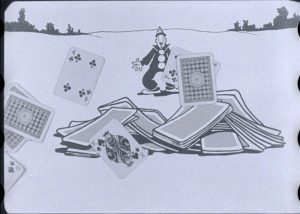
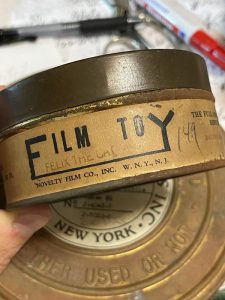
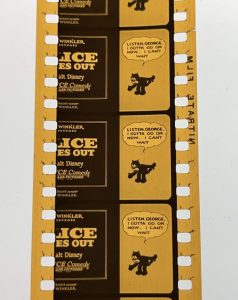
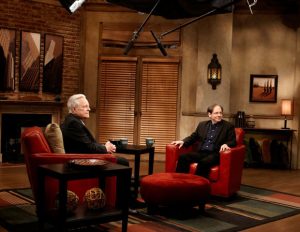
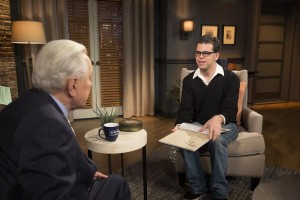
 Tommy Stathes is an animation historian specializing in silent era cartoons. He resides in New York and frequently holds public screenings throughout the city. You can read more about his work, his collection and his research on his website:
Tommy Stathes is an animation historian specializing in silent era cartoons. He resides in New York and frequently holds public screenings throughout the city. You can read more about his work, his collection and his research on his website: 
















































Thank you for all the work you and your colleagues have done in presenting and preserving silent-era animation. It is very much appreciated.
An extended title sequence on ALICE LOSES OUT? Man, I love it when the silents do a fourth wall break, it appears Paul Terry even did it sometimes in his Fables, too; you can see a brief one in THE FARMER AND THE MICE…
As a toast, I’ll give my congratulations to the one and only Tommy for saving these films from extinction, and may there be hope for Farmer Al and others in the future.
It was only last year’s Century Showcase, seeing Fleischer’s cartoons against their direct competition, that I really felt why Walt would tell Richard Fleischer on the Disney studio lot that it should all really belong to his father.
And hurray for TCM! As I scan ahead to program my DVR, I’m always asking myself, “They aren’t secretly making MORE old movies, are they?”
Wasn’t it to Winsor McCays son?
Was it? Let me check the Canemaker book… Yeah, it was while they were recreating the Gertie the Dinosaur stage act.
Don’t know how I transposed it to the Fleishers. And I’m not about to suggest Walt was generous enough to give his studio away twice!
The most common remark I hear is, “No one is interested but you in that.” Everything starts with one person who is interested. That is all it takes. Keep up the great work.
That’s right.
I’m very excited to hear about all this – especially the newly found footage for the early Disney cartoons. For me this is one of the best announcements in this 100 year anniversary of the Disney Studio.
I can’t watch these when they air unfortunately (TCM is now unavailable in my country) so I’m looking forward to the Blu Ray releases.
I cannot WAIT to get the new Cartoons on Film releases! I’ll have my finger posed over the “Add to Cart” button until they’re available!
Me too! All the Cartoon Roots releases so far have been outstandingly good.
Especially looking forward to the Inkwell one!
All the best for today’s show, Tommy. TCM isn’t available in my country either (and neither is MeTV, unfortunately), but I eagerly await the time when these packages will be available on home video. The Cartoon Roots collections are of immense historical interest, of course — but more than that, they’re very entertaining in their own right!
I have this on DVR and will watch it (and record it) later today.
Oh no! Missed it! And it doesn’t seem to be on the TCM app. Will it show up there, or be re-run?
Will it be re-aired?
Thanks for the kind words, everyone. I have no idea if or when the program will air again as a regular broadcast. I have no control/input to that end, and am also not kept informed of any future decisions of that kind. Rest assured, though, that the versions of the films seen in these programs will gradually become available to the public again through other means. Enjoy!
Vintage silent cartoons and NOIR ALLEY on TCM? Excellent! I’m ready for your “Farmer Gray” Cartoon Roots Blu-ray; frequently find the animation and character designs in the Aesop’s Fables hilarious.
We don’t get TCM – sadly – but I’ll be looking forward to seeing some of your – and Steve Stanchfield’s collections in the future!
DVR’d it and the program was tremendous. Thanks for your hard work and dedication (As well as Steve & Jerry’s) Looking forward to all of your future efforts!